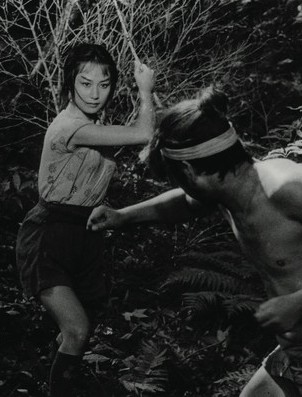Friday, March 7, 1986.
THE HIDDEN FORTRESS (Kakushi toride no san-akunin). Co-written by Ryūzō Kikushima, Hideo Oguni, and Shinobu Hashimoto. Music by Masaru Satō. Co-written, co-produced and directed by Akira Kurosawa. Running time: 139 minutes. Rated Mature with the B.C. Classifier’s warning “some violence.”
A LONG TIME AGO, on an island far, far away . . .
It is a time of civil war. Akizuki clan elders, retreating to a hidden fortress, mourn the loss of their lands to the Yamana empire.
During the battle, Akizuki loyalists managed to secret the clan's gold reserves beneath the waters of a mountain stream, a fortune sufficient to restore the clan to power in a neighbouring state.
Pursued by Yamana's deadly agents, Princess Yukihime races towards Hayakawa territory in disguise, custodian of the golden cache that can save her clan and restore freedom to their land . . .
Sound familiar? Nearly 20 years before Princess Leia thought to entrust the stolen Death Star plans to the droid R2D2, a teenaged Japanese maiden was risking all in a noble cause.
She did it in a film called The Hidden Fortress (Kakushi toride no san-akunin). A Japanese-language feature originally released in 1958, the picture counts among its fans former USC film student George (Star Wars) Lucas, a director who owes a special debt of gratitude to Japan's master filmmaker, Akira Kurosawa.
Made midway between the classic Seven Samurai (1954) and the influential Yojimbo (1961), The Hidden Fortress represents Kurosawa at the height of his powers. Though accolades have been showered upon him for his current [1985] feature, the stolid Ran, I think the older movie is the greater work.
The director's first film in a wide-screen process, The Hidden Fortress is something of a celebration. After two darkly dramatic features inspired by serious, foreign literary sources — Throne of Blood (1956) based on Shakespeare's Macbeth and The Lower Depths (1957) inspired by Maxim Gorky — Kurosawa was ready to cut loose with a full-blooded chambara, a traditional Japanese swordplay epic full of rousing action and high adventure.
Opening with a thunderously heroic symphonic score, the film introduces us to a pair of funny little men arguing on a desolate plain. Though their resemblance to the droids R2D2 and C3PO is more than coincidental, Tahei (Minoru Chiaki) and Matashichi (Kamatari Fujiwara) have tragic as well as comic dimensions.
Two poor farmers who became footsoldiers in the hope of fortune, they lost everything short of their lives in the defeat of the Akizuki clan. Blocked in their attempt to cross the border into friendly territory, they come up with the idea of circling through the homeland of the invading Yamanas.
Life takes a turn for the better when they discover a gold piece in a broken tree branch. Their luck changes again when they encounter a brawny woodcutter who claims to know the location of the missing Akizuki treasure. In his company they discover the hidden fortress.
Unbeknownst to the farmers, they have been conscripted into a daring plot devised by disguised Akizuki clan general Rokurota Makabe (Toshiro Mifune) to run the Yamana blockade. When they leave the safety of his mountain redoubt, they are accompanied by an imperious mute girl, the disguised 16-year-old Princess Yukihime Akizuki (Misa Uehara).
Being shown here in its original epic length — 139 minutes — Kurosawa's sweeping feature has all the elements of grand adventure entertainment. There is suspense, as our heroes fall in and out of enemy clutches, along with the thrill of dangers encountered and hairbreadth escapes.
There is spectacle, as we witness the violence of a slave revolt and an ecstatic fire ritual. There is the intensity of one-on-one combats between master warriors, and the comedy of those ever-greedy, always argumentative farmers.
As shaped by Kurosawa, the picture remains a superior example of genre movie-making, and a subtly telling commentary on its own heroic conventions. The Hidden Fortress is both a good film and a great one.
The above is a restored version of a Province review by Michael Walsh originally published in 1986. For additional information on this archived material, please visit my FAQ.
Afterword: One indication of Akira Kurosawa's lasting influence is the fact that over the years many major filmmakers have sincerely flattered him by imitating his pictures. American director John Sturges was among the first, remaking Seven Samurai as a Western called The Magnificent Seven (1960). In 1964, Italy's Sergio Leone made his first "spaghetti Western" Per un pugno di dollar (A Fistful of Dollars), a remake of Yojimbo, while another American, Martin Ritt, remade Kurosawa's Rashomon as The Outrage. In 1980, Roger Corman's Battle Beyond the Stars put a comic sci-fi spin on Seven Samurai. Walter Hill paid his respects in 1996 with Last Man Standing, another retelling of Yojimbo, set during the U.S. prohibition era.
What goes around comes around. By the late 1970s, Kurosawa was unable to get his ambitious productions financed. It was his early fan George Lucas who made it possible for him to continue making films. Together with Francis Ford Coppola, Lucas pressured Star Wars distributor 20th Century Fox into co-financing Kurosawa’s 1980 feature, Kagemusha (a.k.a. Shadow Warrior). Both a financial and critical success, it earned Oscar nominations for best foreign-language film and art direction. Kurosawa went on to make 1985’s Ran, a period tragedy inspired by Shakespeare’s King Lear. Though I found it a less compelling film than The Hidden Fortress, the critical consensus is that it is among the director’s finest achievements.
See also: Included in the Reeling Back archive is director Akira Kurosawa’s penultimate feature film, 1991’s elegiac Rhapsody in August.
